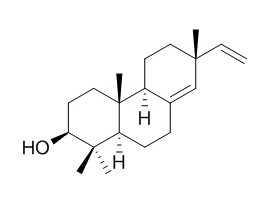8(14),15-Isopimaradien-3-ol
ent-8(14),15-pimaradien-3beta-ol (8(14),15-Isopimaradien-3-ol) can induce vascular relaxation. It displays high antibacterial activities (MIC values lower than 10 microg /mL for most pathogens).
Inquire / Order:
manager@chemfaces.com
Technical Inquiries:
service@chemfaces.com
Tel:
+86-27-84237783
Fax:
+86-27-84254680
Address:
1 Building, No. 83, CheCheng Rd., Wuhan Economic and Technological Development Zone, Wuhan, Hubei 430056, PRC
Providing storage is as stated on the product vial and the vial is kept tightly sealed, the product can be stored for up to
24 months(2-8C).
Wherever possible, you should prepare and use solutions on the same day. However, if you need to make up stock solutions in advance, we recommend that you store the solution as aliquots in tightly sealed vials at -20C. Generally, these will be useable for up to two weeks. Before use, and prior to opening the vial we recommend that you allow your product to equilibrate to room temperature for at least 1 hour.
Need more advice on solubility, usage and handling? Please email to: service@chemfaces.com
The packaging of the product may have turned upside down during transportation, resulting in the natural compounds adhering to the neck or cap of the vial. take the vial out of its packaging and gently shake to let the compounds fall to the bottom of the vial. for liquid products, centrifuge at 200-500 RPM to gather the liquid at the bottom of the vial. try to avoid loss or contamination during handling.
Int J Anal Chem.2017, 2017:1254721
Int J Mol Sci.2023, 24(23):17118.
NanoBioScience2024, v13:3:115.
Lab Chip.2018, 18(6):971-978
Journal of Mushroom2023, 21(4):215-221.
Food Analytical Methods2020, 1-10
Biomedicines.2021, 9(8):954.
Life (Basel).2021, 11(12):1399.
J Appl Biol Chem.2022, 65(4):pp.463-469.
J Ethnopharmacol.2024, 324:117775.
Related and Featured Products
Eur J Pharmacol. 2009 Aug 15;616(1-3):183-91.
Mechanisms underlying the vasorelaxant action of the pimarane ent-8(14),15-pimaradien-3beta-ol in the isolated rat aorta.[Pubmed:
19540222 ]
Pimarane-type diterpenes were described to exert antispasmodic and relaxant activities. Based on this observation we hypothesized that the diterpene ent-8(14),15-pimaradien-3beta-ol (ent-8(14),15-Isopimaradien-3-ol,PA-3beta-ol) induced vascular relaxation. With this purpose, the present work investigates the mechanisms involved in the vasorelaxant effect of the pimarane-type diterpene PA-3beta-ol.
METHODS AND RESULTS:
Vascular reactivity experiments, using standard muscle bath procedures, were performed in isolated aortic rings from male Wistar rats. Cytosolic calcium concentration ([Ca(2+)]c) was measured by confocal microscopy using the fluorescent probe Fluo-3AM. PA-3beta-ol (10, 50 and 100 micromol/l) inhibited phenylephrine and KCl-induced contraction in either endothelium-intact or denuded rat aortic rings. PA-3beta-ol also reduced CaCl(2)-induced contraction in Ca(2+)-free solution containing KCl (30 mmol/l) or phenylephrine (0.1 micromol/l). PA-3beta-ol (1-300 micromol/l) concentration dependently relaxed phenylephrine-pre-contracted rings with intact or denuded endothelium. The diterpene also relaxed KCl-pre-contracted rings with intact or denuded endothelium. Moreover, Ca(2+) mobilization study showed that PA-3beta-ol (100 micromol/l) and verapamil (1 micromol/l) inhibited the increase in Ca(2+)-concentration in smooth muscle and endothelial cells induced by phenylephrine (10 micromol/l) or KCl (60 mmol/l). Pre-incubation of intact or denuded aortic rings with N(G)-nitro-l-arginine methyl ester (L-NAME, 100 micromol/l) and 1H-[1,2,4]Oxadiazolo[4,3-a]quinoxalin-1-one (ODQ, 1 micromol/l) produced a rightward displacement of the PA-3beta-ol concentration-response curves. On the other hand, 7-nitroindazole (100 micromol/l), 1400 W (1 micromol/l), indomethacin (10 micromol/l) and tetraethylammonium (1 mmol/l) did not affect PA-3beta-ol-induced relaxation.
CONCLUSIONS:
Collectively, our results provide evidence that the effects elicited by PA-3beta-ol involve extracellular Ca(2+) influx blockade. Its effects are also partly mediated by the activation of NO-cGMP pathway.
Fitoterapia. 2009 Oct;80(7):432-6.
Antimicrobial ent-pimarane diterpenes from Viguiera arenaria against Gram-positive bacteria.[Pubmed:
19524643 ]
METHODS AND RESULTS:
The dichloromethane crude extract from the roots of Viguiera arenaria (VaDRE) has been employed in an antimicrobial screening against several bacteria responsible for human pathologies. The main diterpenes isolated from this extract, as well as two semi-synthetic pimarane derivatives, were also investigated for the pathogens that were significantly inhibited by the extract (MIC values lower than 100 microg mL(-1)). The VaDRE extract was significantly active only against Gram-positive microorganisms. The compounds ent-pimara-8(14),15-dien-19-oic acid (PA); PA sodium salt; ent-8(14),15-pimaradien-3beta-ol(ent-8(14),15-Isopimaradien-3-ol); ent-15-pimarene-8 beta,19-diol; and ent-8(14),15-pimaradien-3beta-acetoxy displayed the highest antibacterial activities (MIC values lower than 10 microg mL(-1) for most pathogens).
CONCLUSIONS:
In conclusion, our results suggest that pimaranes are an important class of natural products for further investigations in the search of new antibacterial agents.



